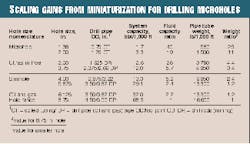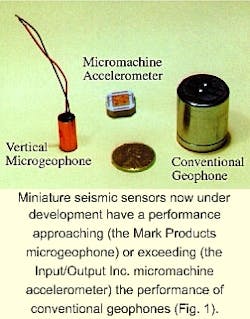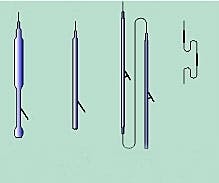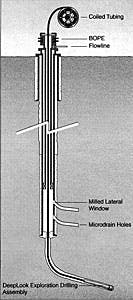Development of technology to drill small-diameter boreholes and the imminent marriage of this technology with micro-instrumentation can result in low-cost, deep wells for both exploration and instrumentation access.
These boreholes, called microboreholes or simply microholes, can have diameters of 1 3/8 to 2 in. at terminal depth.
As access for instrumentation, the availability of microholes can encourage and support improved reservoir characterization, monitoring, and management. Microholes also offer the possibility of extending existing wells without pulling production tubing and of serving as drain holes or root systems.
A fresh look at the feasibility of drilling deep, small-diameter boreholes is warranted by recent advances in drilling technology, progress in the long-term development of more reliable, miniaturized electronics and sensors, and the consequent proliferation of potential uses for microholes in exploration and production management.
This article examines some of the rationale, benefits, and sources of cost reduction for microholes; a concluding article next week details the technical feasibility of drilling deep microholes.
Conventional drilling
Historically, wellbore diameter has been influenced by both the well's ultimate use and the available drilling technology. Deep well diameters evolved to support exploration, which usually included coring, logging, and drill-stem formation tests as well as production, which has typically required a relatively large flow rate during the early part of a well's commercial life.
To support these activities, deep drilling systems evolved to produce holes between 6 and 12-in. diameter through the production interval and larger holes for the surface and intermediate casings needed to reach production depths.
Only infrequently have nonproduction infield wells been drilled with the same systems and dedicated to collecting data and monitoring reservoir processes.
Infrastructure, experience, and the prevailing economics for wells dedicated to production have limited any transition to smaller-diameter holes. While technically demonstrated and perhaps more suited to applications other than production, the drilling of slimholes 4-57/8-in. diameter in many cases generally has not been a commercial success.
The potential cost saving, for example, of the widespread adoption of slimholes for exploration is significant but is yet insufficient for development of supporting equipment and services.1
Instrumentation
The evolution from transistor-based circuits to application-specific integrated circuits has provided a substantial reduction in the size of electronic circuits needed to support downhole data acquisition. Technological advances have also resulted in smaller sensors without loss of performance.
Fig. 1 shows an example of the miniaturization of a conventional geophone and a micromachine accelerometer used to obtain seismic data.1-3
Downhole instrumentation packages to support both exploration and reservoir management can, in many cases, be made substantially smaller than conventional commercial packages routinely in use today.
Once the potentially large nonrecurring engineering and development costs are paid out, the actual cost of the packages may in many cases be significantly lower than conventional borehole logging tools and instrumentation packages. Fig. 2 shows an example.
A 1/2-in. diameter borehole geophone array and a 7/8-in. diameter micromachine accelerometer array intended for use in microholes are the most recent addition to a family of experimental borehole geophone packages developed by Los Alamos National Laboratory.
This development began in 1975 with instruments housed in a 5 1/4-in. diameter, severe-environment borehole instrumentation package, and has progressed to packages suitable for use in microholes.
If only the basic function of detecting seismic waves is considered, development and replication costs of the 1/2-in. geophone tool in 1996 were less than 10% of the 111/16-in. diameter through-tubing tool that was prototyped only a few years earlier.
Microhole economics
For exploration and instrumentation-access wells, reduction of scale to decrease costs becomes economically much more attractive when carried to microhole dimensions.
Two examples of the savings due to miniaturization are shown in Table 1, which gives comparisons between a hypothetical 13/8-in. diameter microhole and commonly drilled 83/4-in. production wells in terms of well volume and drillstring weight.
Both the absolute value and the ratio of the microhole value to that of the 8 3/4-in. hole are also shown. For a microhole, the volume of the drilling fluid and the weight of the drill can be as little as 1/42nd and 1/77th, respectively, of that for a nominal production well. This compares with a two to five-fold reduction in scale for a slimhole.
Because of scaled-down weight and material requirements for microholes, there is a potential savings in nearly every aspect of a hypothetical microdrilling system.
In concept, components of a microdrilling system are miniaturized versions of what is for the most part familiar conventional drilling and coiled-tubing technology. Consequently, to the first approximation, microhole drilling will have the same characteristics and limitations of conventional drilling technology but will have the savings inherent in the scale reduction.
With drilling equipment this small, microhole drilling system can be produced with a comparatively small investment and on a short development cycle.
Other advantages suggest themselves for microhole drilling.
A coiled-tubing drillstring may be run and set as a production casing or liner. Low materials costs may make labor the principal cost of fabricating miniaturized components.
Low materials costs for fabrication of miniaturized components would allow high-volume production and routine replacement of system components, thus reducing inspection and down time to achieve high-reliability drilling systems.
Because of the small well and annular volumes, specialized muds, cements, epoxies, and tubing materials not normally considered because of cost may be used to improve drilling performance and the end-use of the well.
The overall footprint of a microhole drilling system on site will be small compared to current systems. Perhaps just as important is that miniaturization of drilling systems will substantially reduce the capital cost for developing the inventories of drilling and support equipment needed to commercialize the drilling systems.
A preliminary estimate based on very conservative assumptions has the cost of routinely drilling microholes showing a savings of 70% over comparable conventional production wells, with much greater savings being possible as techniques are refined and the drilling platforms are optimized for specific drilling missions.
New applications
Future development of oil reservoirs in decreasing size will depend heavily on reduced exploratory drilling costs. Miniaturization of conventional drilling systems and borehole measurement technologies will be important in reducing costs.
Reduction in hole size represented by microholes will not be an obstacle in obtaining the information normally acquired through exploration and reservoir delineation wells, including cuttings, core, fluid samples, pressure, formation gamma, resistivity, and, in the future, a wide variety of micro-versions of currently available formation-property logs.
Efficient delineation and prudent development of existing reserves dictate the rapid implementation of new technology. The economics of deferred production limit the long-term access to reservoirs for wells formerly or currently dedicated to production.
As a result, long-term in situ measurements taken in producing fields are now infrequent and made in less-than-ideal locations and conditions. These measurements often represent only the near-well environment that is usually disturbed or depleted and sometimes isolated from the active reservoir.
Consequently, measurements and samples cannot be obtained in existing wells that meet, for example, the statistical requirements of the latest computer models used for simulating future production and reservoir economics.
Ideally, one would like to collect samples, run logs, and place long-term monitoring instruments in reservoirs where critical information is required. Microhole in-field drilling will satisfy this need.
Effective field management often requires monitoring the gas cap as well as the progress of secondary and tertiary floods. The advent of time-lapse, three-dimensional seismic imaging makes real time monitoring of reservoirs possible. To be effective, sensors will need to be left in place over the productive lifetime of a field.
For the foregoing applications, the microhole environment will be conducive to better measurements. For example, crossflow between formations and gas separation in the fluid column can be prevented in cased, well-cemented microholes.
Consequently, the high borehole noise environment typically associated with seismic measurements in production wells can be avoided and the quality of the seismic data in a microhole will be of greatly improved quality.
Exploration from existing wells
The small size of microhole coiled tubing and bottom hole assemblies and the demonstrated pressure control for current coiled-tubing operations will make microhole drilling possible without removing the production string from existing wells (Fig. 3).
Among the possible applications, the DeepLook Collaboration is interested in exploration and has funded initial steps leading to the development and testing of prototype 1-in. drilling motors.4 5
Acknowledgments
Microhole technology development is supported by the National Petroleum Technology Office and the Federal Energy Technology Center of the US Department of Energy.
References
- "Slim Holes, Slimmer Prospects," JPT, November 1995.
- Albright, J.N., Woo, D., Fairbanks, T., Rutledge, J.T., Thompson, J.D., Howlett, D., and Barge, D., "Development and testing of a 0.5-inch microhole geophone package," SEG International Exposition and 68th Annual Meeting, Sept. 13-18, 1998, New Orleans.
- Albright, J.N., Gannon, J.D., Fairbanks, T.D., and Rutledge, J.T., "Borehole testing of a micromachined silicon accelerometer," SEG International Exposition and 69th Annual Meeting, Oct. 31-Nov. 5, 1999, Houston.
- Gannon, J.C., McMahon, M.C., Phan, H.T., and Speller, K.E., "A seismic test facility," SEG International Exposition and 69th Annual Meeting, Oct. 31-Nov. 5, 1999, Houston.
- DeepLook, August 1997 press release, http://www.deeplock.com, 1999.
The Authors
Jim Albright is leader of the geoengineering group at Los Alamos National Laboratory, Los Alamos, NM. He joined Los Alamos in 1974. His research has been in borehole seismics applied to reservoir imaging and fracture mapping.
Albright holds a PhD in geophysical sciences from the University of Chicago.
Don Dreesen is a staff member in the geoengineering group at Los Alamos National Laboratory. He started at Los Alamos in 1981 He has participated in well technology projects, including borehole instrumentation development. Dreesen holds a BS in electrical engineering from the University of New Mexico and 10 years' experience in oil and natural gas and production and drilling.







